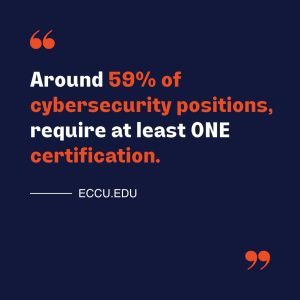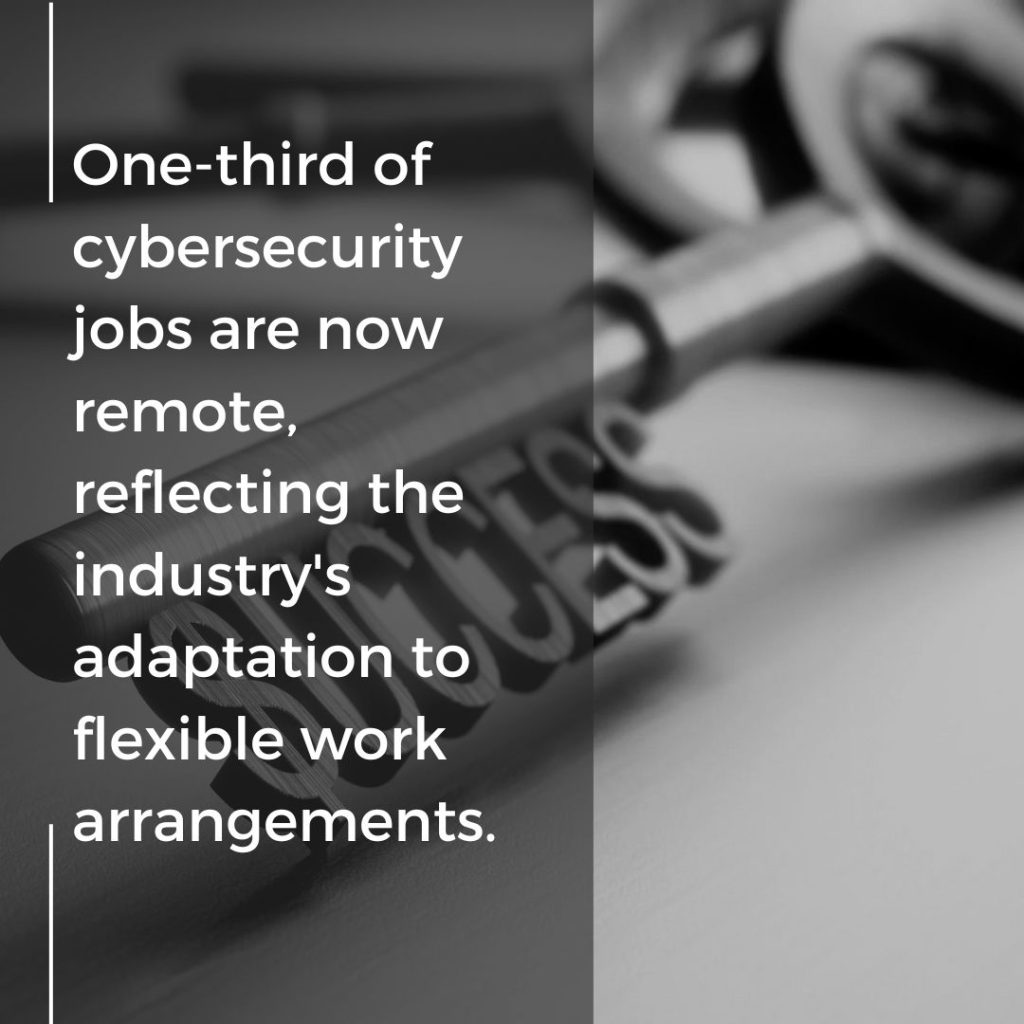
Cybersecurity isn’t just a booming industry—it’s practically in overdrive.
According to the U.S. Bureau of Labor Statistics information security employment is expected to grow by 35% by 2031.
That’s a staggering rate compared to most industries.
With the rise of A.I-powered fraud schemes, Cybersecurity Ventures, estimates global cybercrime costs will soar to $10.5 trillion USD in 2025–an increase of $3 trillion USD from 2015.
Cyber threats are not slowing down anytime soon.
And that’s why companies all over the world will continue to look for competent professionals to fill IT security roles.
More than a Desk Job
Every time security professionals prevent data breaches, ransomware attacks or phishing scams, they are protecting individuals from financial ruin and safeguarding critical infrastructure.
A career in cybersecurity doesn’t mean sitting behind a screen in a basement.
Sure, some roles are deeply technical, but there are a variety of opportunities you can choose from.
- SOC Analysts: Front-line defenders, watching for threats and responding in real-time.
- Penetration Testers: Ethical hackers who break into systems before the bad guys do.
- Cloud Security Specialists: Protects data when companies shift to platforms like AWS and Azure.
- Digital Forensics Investigator: Analyzes devices and logs to trace the origin of an attack for legal cases and corporate investigations.
- Threat Intelligence Analyst: Studies threats, tracks hacking groups and predicts attacks before they happen.
- Governance, Risk and Compliance (GRC) Specialist: Creates policies, conducts risk assessments and helps businesses maintain security standards.
- Incident Responders: People called in when things go drastically wrong. They work under high pressure to contain breaches.
Additionally there’s room to grow into leadership roles like CISO (Chief Information Security Officer), Security consultant or cybersecurity architect.
Key Technical & Soft Skills Required
- Networking fundamentals: Understanding TCP/IP, firewalls and VPNs help secure data traffic.
- Scripting and Automation: Python, Bash and PowerShell are the most common for security automation.
- Risk Assessment: Identifying vulnerabilities and assessing their impact to prevent harmful breaches.
- Communication: Explaining technical risks and cybersecurity lingo to non-technical teams and executives.
- Problem-solving: Ability to think critically and respond quickly to crucial incidents.

Step-by-Step Guide to Getting Started in Cybersecurity
Some of the best security professionals didn’t start with a degree or formal training.
Many professionals tinkered with computers, participated in hacking challenges and learned from practical experiences.
Step 1: Learn the Basics
Understanding how computers communicate is the first step.
Networks, operating systems and security principles are the foundation for cybersecurity.
A basic grasp of networking is to understand how data moves between devices through the concepts of TCP/IP, DNS and firewalls.
Free Resources
- YouTube: Channels like Network Chuck, Professor Messer and HackerSploit offer tutorials on cybersecurity concepts.
- Cybrary: Free courses cover security fundamentals, ethical hacking and SOC operations.
- TryHackMe: Interactive labs provide a hands-on introduction to penetration testing and security concepts.
Step 2: Choose a Specialization
Pick a focus early as it helps structure your learning in a broad cybersecurity industry.
Roles include:
- Cybersecurity analyst
- Penetration tester
- Cloud security specialist
- Digital forensics investigator
- Threat intelligence analyst
One way to determine what suits you is by testing different skills. Set up a virtual lab, test basic ethical techniques or experiment with cloud security settings on AWS’s free tier.
Step 3: Acquire Practical Experience
Theory alone won’t get you hired.
Employers want proof that you can solve problems in real-time.
Here’s how to get practical experience.
Set Up a Home Lab
Building your own cybersecurity lab is a starter kit for sharpening your skills.
A virtual lab can be created by using:
- VirtualBox or VMware – Run different operating systems like Kali Linux and Windows Server.
- Metasploitable – An intentional vulnerable machine for penetration testing practice.
- Security Onion – Free Linux distro for threat funding and intrusion detection.
Participate in Capture the Flag (CTF) Challenges
CTFs are competitive hacking challenges that test problem solving skills.
Platforms like Hack the Box and TryHackMe offer beginner-friendly exercises.
Many cybersecurity professionals mention CTFs in their resumes or job interviews because they highlight that hands-on skills are better than tertiary degrees.
Contribute to Open-Source Security Projects
Many open-source projects welcome beginners.
Contributing to security tools on GitHub shows initiative and provides real-world experience.
Some popular projects to explore include:
- OWASP ZAP – A web security scanner used for penetration testing.
- TheHive – An incident response platform for security teams.
- Sigma – A project focused on detection rules for security operations.
Employers value contributions to these projects because they demonstrate team work, coding skills and an ability to work with industry-standard tools.

Industry Certifications
Certifications aren’t a replacement for experience, but can open doors for entry-level roles.
According to Cisco, 78% of hiring managers prefer candidates with at least one technical certifications.
- CompTIA Security+: Covers essential cybersecurity concepts and is widely recognized.
- Certified Ethical Hacker: Focuses on penetration testing techniques.
- AWS Security Specialty: Ideal for those interested in cloud security.
- CISSP: Best for advanced professionals with work experience.
Step 4: Build a Cybersecurity Portfolio
Showcase Your Skills.
One of the best ways to demonstrate your skills is by initiating hands-on projects.
Use TikTok to share cybersecurity tips or write about topics you have studied and upload them on a blog.
Host projects on GitHub to show you can solve real-time problems.
Consider creating and adding vulnerability reports or mock security assessments to your portfolio.
Create Your Resume and LinkedIn Profile
On your resume, focus on what you’ve learned in your certifications and personal projects.
Highlight internships and volunteer work related to cybersecurity and avoid technical jargon.
For LinkedIn, make sure your profile reflects your passion—share blog posts, projects and certifications.
Connect with industry professionals and engage in discussions to build your network.
Step 5: Network and Find a Mentor
Connecting with professionals through platforms like TalentMakers Foundation (TMF) throws doors wide open and provides guidance for career advancement.
- Join Cybersecurity Communities: Stay updated on the latest trends on Reddit, LinkedIn, Discord, and X, where you can ask questions, share your experiences, and get advice. At TMF, we encourage our learners to engage with these communities to expand their knowledge and professional network.
- Attend Virtual Conferences & Meetups: Events like Black Hat, DEFCON and BSides offer opportunities for networking and growth.
- Get a Mentor: Get a mentor that offers insight on the skills you need and can introduce you to industry contacts and job opportunities.

Step 6: Start Applying for Jobs
Now that you have built a solid portfolio, earned certifications and grown your network..it’s time to start looking for jobs.
Find Entry-Level Opportunities
Search on Indeed, Glassdoor, Upwork and LinkedIn.
The majority of companies seek candidates with foundation cybersecurity skills and a willingness to learn and grow in the field.
Tailor Your Resume
Customize your resume for each position.
Highlight certifications, relevant coursework, personal projects, internships and volunteer work.
Ensure your security-specific accomplishments are front and center.
Common Interview Questions
Expect questions about your technical knowledge, problem-solving abilities and how you would handle cybersecurity challenges.
Always prepare by reviewing the basics and understanding how to approach security problems logically.
Final Thoughts
Cybersecurity offers a rewarding career path filled with opportunities to learn and grow.
By getting certified, building a portfolio, networking with experts and applying for jobs strategically, you’ll position yourself as a strong candidate.
Remember to start by focusing on foundational areas like network basics and IT fundamentals.
This gives you a solid foundation for exploring more advanced aspects of cybersecurity.
Focus on small wins.
Never compare yourself to seasoned professionals.
Celebrate every milestone.
Every step forward, no matter how little is progress.
Stay curious.
Keep upskilling.
And never stop learning because cybersecurity is always evolving.
About TalentMakers Foundation
TalentMakers Foundation is a non-profit organization dedicated to empowering young Africans with in-demand tech skills and global career opportunities.
Our mission is to equip the next generation of African tech leaders with the skills they need to thrive in artificial intelligence, data science, cybersecurity and emerging technologies.
Apply for our human capacity developmental programs, become a mentor or support our initiatives today!


